Part of being a prepper is accumulating the right gear and the right supplies. The time to get what you need is not the moment you need it!
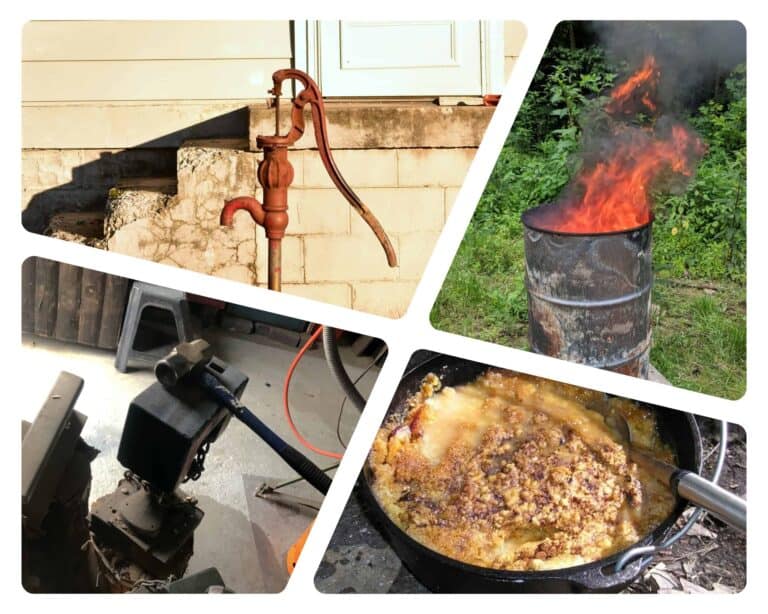
I think all of us know that, but even if we’ve spent a lot of time, effort, and money preparing for long-term survival scenarios, I fear most of us haven’t thought through the consequences of an indefinite-duration scenario…
When the merde hits the fan at Mach velocity, consider that society might come crumbling down pretty much forever.
Commerce, supply lines, manufacturing, and even global trade might come to a screeching halt. That means that as the things we rely on to get us through wear out or just run down, there won’t be any replacements.
We’ll see a prolonged period of technological regression. That doesn’t mean we give up, but it does mean we must be able to adapt. The best way to adapt to these circumstances is to reach for the tools that our pioneer ancestors relied on. Many of them are still surprisingly effective!
Below, I’ll take you through 20 must-have pioneer tools that will help you survive and thrive post-SHTF.
Canning Kit
Here’s one pioneer kit that most of us use today, or at least have someone in our family that uses it! At-home canning is one of the very best ways to preserve food, whether it is food that you raised yourself or brought home from the grocery store.
Canned foods are convenient, stable at room temperature, and ready to eat as soon as you crack them open.
Fruits, veggies, meats, and more can all be preserved through proper canning… but, it’s just as much art as science and not quite as straightforward as most people think.
Disclosure: This post has links to 3rd party websites, so I may get a commission if you buy through those links. Survival Sullivan is a participant in the Amazon Services LLC Associates Program. As an Amazon Associate, I earn from qualifying purchases. See my full disclosure for more.
It’s best to get the gear now and become proficient with it. Start putting your food back today, and give thanks that you have a full water bath canning set if society ever collapses; the stuff will be worth its weight in gold!
Oil Lamps
For countless decades before the advent of the electric flashlight and lantern, our ancestors relied on oil lamps.
Although they have a bad rep today as being a stupendous fire hazard (and they are if there is an accident), oil lamps are versatile, simple, and capable of running on a variety of fuels.
You might be able to make use of cooking oil, kerosene, and a lot more in a pinch. This makes them the perfect long-term lighting option when our electrical grid completely implodes and factories aren’t churning out any more batteries.
And before you smart preppers out there pipe in with your rechargeable batteries and solar charging system, do keep in mind that even those batteries will eventually die! When they do, you’ll be glad you have several of these.
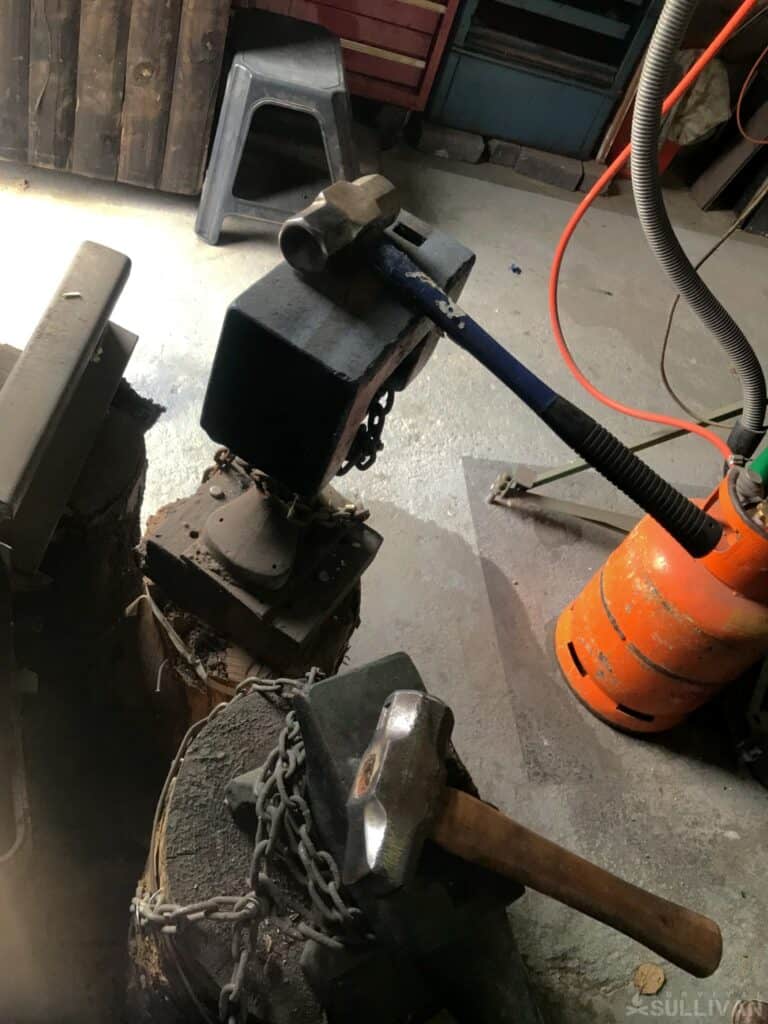
hammers and anvil
Anvil
Today, blacksmithing is seen as a quaint hobby or an ultra-niche industry for reproduction goods or decorative items with a certain rustic appeal.
But for centuries, it was foundational to society, and the town or county blacksmith, along with his apprentice, was a pillar of the community.
You might find blacksmithing a rewarding hobby now, but if you take it seriously, the ability to make and repair horseshoes, tools, nails, hinges, and more might be the only thing that keeps society running in your neck of the woods. To do that, you’ve got to have a good anvil.
You can make a forge from almost anything, but an anvil is another proposition entirely! Get one now before it is too late.
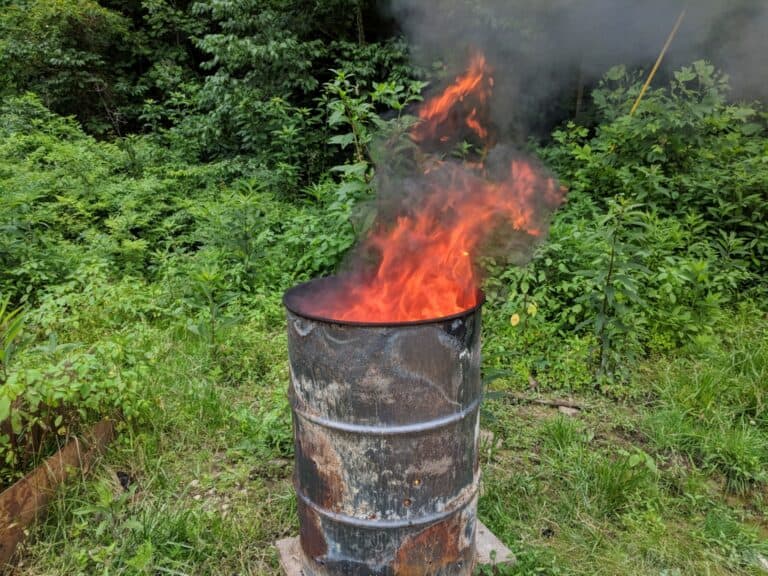
a functioning burn barrel close-up
Rain Barrels
One of the smartest things that our pioneer forbearers did was catch rain at every opportunity. Today, drought is more often a nuisance than anything else, at least in the West. Back then, it could be a death sentence.
When your crops and animals are depending on regular watering, and of course, you and your family need water to drink, you’d better have plenty on hand when it won’t just come out of a tap anymore.
Rain barrels and other catchment systems are critical for sustainment in the post-SHTF world: hooking up a simple diverter system to the gutters on your home and then connecting that to a daisy chain series of barrels can net you hundreds of gallons of water from one good afternoon thunderstorm.
For extra points, learn how to craft your own wooden rain barrels.
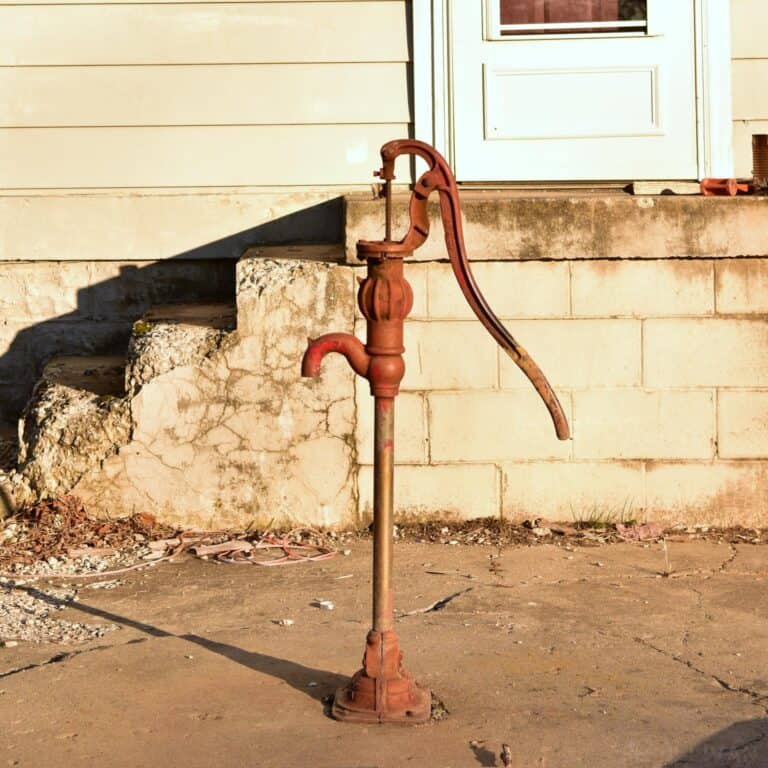
A hand pumped water source in the backyard.
Hand Pump
Pumps are one of those things we take for granted in society today. They are absolutely critical for bringing our water up from our wells, for moving waste through sewer pipes, and keeping fuel flowing.
Back in the day before the Industrial Revolution, we had pumps, but most of them were powered by muscle, not electricity or steam.
You are wise to invest in various hand pumps now while you can. Hand pumps for shallow and sandpoint wells can keep the water flowing when other sources give up, and you can use hand pumps and siphons to draw liquids out of fuel tanks and countless other tasks.
Wind-Up Clocks
We don’t have to get all philosophical about time itself to understand the value of being able to tell time. This is another one of those things that has become so ubiquitous, so embedded, and so ingrained in society that we treat it just like breathing: it’s guaranteed.
But once again, the reality will be anything but in the post-collapse world. Electric clocks will inevitably die, including the one in your smartphone, the watch on your wrist, and the alarm clock by your bed.
But the ones that won’t die, with care, are mechanical clocks. And yes, I mean the ones that need winding.
A fine mechanical timepiece is a joy, but more than that, it is a great hedge against the loss of electronic timekeeping. Whether you want a proper grandfather clock, a wind-up desk clock, or even a festive cuckoo clock, just make sure you have one.

peach cobbler cooking in cast iron Dutch oven over outdoor fire
Dutch Oven
Here’s another piece of pioneer tech that many of us will be intimately familiar with, and many more will already use it every day. In the kitchen, at the campsite, or in the backyard, a cast iron Dutch oven is a true Swiss Army knife when it comes to cookware.
Using nothing more than a Dutch oven, you can bake bread, grill, roast, broil, simmer, and more. There’s almost nothing you can’t make with it, and the versatility of the humble Dutch oven is rivaled only by its durability. There truly is nothing to go wrong short of melting the thing down in the furnace.
My favorite type is the so-called combo cooker, where the lid can be flipped over and used as a separate skillet. That will give you even more versatility!
Grain Mills
Hardly anything is more instrumental for the production of bread and other baked goods than a grain mill.
Whatever the design, a grain mill is the tool you need to process harvested grain into flour, and from flour, you’ll get bread. Bread feeds the world, and it will keep you alive when most other food sources run out.
If you look at the design of a grain mill on paper, you will mistakenly think that it is so easy you can just whip one together from a few stones when you need it.
Nothing is further from the truth, and crafting one that is both effective and easy to use is quite a feat. Again, you can save yourself a ton of trouble by getting your hands on one now and learning how to use it.
Hand-Cranked Grinders
Sort of a complement to the grain mill, hand-crank grinders can be used to process things like coffee beans, herbs, and a lot more. Some are purposefully-made to grind meat.
This is a perfect kitchen gadget to invest in right now, as plenty are still manufactured, and many high-quality ones exist for coffee lovers who are constantly in search of the perfect cup of joe.
If you’re up for a challenge, track down a vintage model which might need a little TLC to restore to working order.
Most of these older ones are made from cast iron and other heavy components which will last basically forever with a little bit of care. This is one pioneer tool you can enjoy using every day in your own kitchen while times are good, too!
Spinning Wheel
When you have harvested raw wool, cotton, flax, or any other fiber that is suitable for making into fabric, you’ll need to send it through a spinning wheel to turn it into thread, which can then be processed into fabric.
As you might have guessed, this was once a technology that was used by pioneer families to make both goods for selling and goods for their own use. Once you’ve made thread, you can use the next item on our list to make fabric.
Hand Loom
If you want to weave fabric from any thread or yarn you’ve made with your spinning wheel, you’ll need a hand loom. Although they look simple (and I guess they are), using them requires a considerable amount of practice and some expertise.
First, threads are stretched vertically and horizontally across the frame, referred to as warp and weft threads respectively. These are manipulated by pedals and meters as the shuttle moves back and forth between them, individually assembling each of the strands into a sturdy piece of fabric.
If you want to make clothing, blankets, and any other substantial fabric items quickly and easily, you’ll need one of these and the skills to use it.
Manual Sewing Machine
Repairing your clothing, tarps, and any other fabric goods you have on hand is essential to getting the longest life out of them you can.
Simple, coarse repairs can be done by hand easily and quickly enough, but for major repairs or intricate modifications, you’ll need a sewing machine.
Electric sewing machines are great, but even if you have electricity to run them post-SHTF, they won’t last forever, and they can be difficult to repair themselves.
Instead, you can turn to a manual sewing machine, which is exactly what it sounds like. Powered by a hand crank or a treadle (footboard), they are easy to use with just a little bit of practice, and they are typically so rudimentary that they will last basically forever with little care.
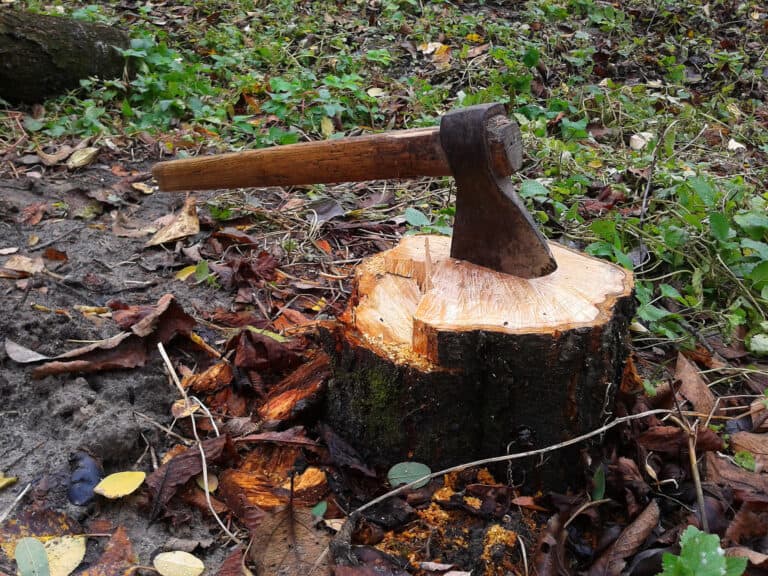
axe in tree stump
Axe
When it comes to processing wood around the homestead, nothing beats a good axe. For chopping off limbs, felling trees, bucking logs, and even light splitting, axes can handle business and are one of the most versatile tools around.
Make sure you get a good one, learn how to sharpen it, and learn how to re-haft it (lingo for replacing the handle).
It’s easier than you think, and with a little practice, you’ll be shocked at how fast and efficient you can be with one of these.
Scythes
An ancient agricultural tool, scythes are used to cut down tall grasses and thin, reedy plants, and do so in a tidy, level fashion. For harvesting cereals and other similar crops, this is a must-have, and it makes a shockingly effective manual lawnmower with a little bit of practice.
A scythe will come in really handy for maintaining your property and tending to your crops. These tools are also a great candidate for fabrication if you have the requisite blacksmithing skills for the blade, and woodworking skills for the handle.
Crosscut Saw
Another essential forestry tool and one that will help you and a friend process wood for fire, furniture, building, or any other task you have in mind. For really big trees, cutting them down with a crosscut saw takes a lot less time and less effort compared to an axe.
Once they are down, you can then use the saw to easily buck the trunk into more manageable sections for transport or processing on-site. Like all tools, these require maintenance, but sharpening the individual teeth is surprisingly easy with a little practice.
Hand Auger
A hand auger is basically a large, hand-powered drill, and perfect for making quick holes in wood and other soft materials.
It’s a mainstay if you’re resorting to simplified construction and crafting techniques, and is adaptable to all kinds of work.
Do note that you’ll have to put in plenty of elbow grease to get through hardwoods, and if you want this tool to go the distance, you must learn how to maintain drill bits. They need sharpening too, you know!
Draw Knife
Another specialized wood-shaping tool, and one that many preppers overlook, a draw knife is a long, straight or gently curved blade with a handle on either end.
It sort of looks like a miniature two-man crosscut saw without any teeth. As you expect, in operation, the blade is pulled, or drawn, back towards the user to shave off bark and shape wood.
It has been a mainstay of wood crafting for centuries in various forms, and it is still a surprisingly effective tool today. You’ll find it comes in really handy for building structures from roughly shaped logs.
Flint and Steel
This is one pioneer tool that most preppers are already well-acquainted with, most likely.
Before we had lighters, before we had matches, and way before we had factory-produced ferro rods, mankind relied on a piece of flint and a hard piece of steel for quick, reliable fire-starting in all conditions.
By scraping the steel along the flint, or doing the reverse, you can produce a shower of hot sparks and particles that will easily ignite good, dry tinder. There’s a knack to it, but it’s easily learned. Practice now so it will be easy later.
Wagons
Wagons, of all kinds, will be invaluable for helping you move cargo and people in the aftermath of a societal collapse and serious technological retrogression.
Whether it is a small one that can be pulled by hand, a larger one that can be towed by a draft animal, or a large one that requires a team of such animals, it’s a good idea to start familiarizing yourself with the basic concepts of constructing, repairing, and limbering wagons.
Keep in mind that towing a wagon with animals requires specialty tack and harness to hook it up to the animal safely and, relatively, comfortably. This is a separate category of gear you’ll need to familiarize yourself with.
Butter Churn
Everyone knows that butter is a dairy product, but do you know how it’s actually made? It is churned, in a butter churn!
Anyone familiar with the Amish way of life is probably familiar with the operation of a butter churn, but like all the tools on our list, it does a remarkably good job and requires only plenty of elbow grease in return.
Churning butter can be a lengthy process, making it a chore that is often shared between family members in shifts throughout the day.
Considering how useful butter is in cooking and baking, and how valuable it’s likely to be post-SHTF, a good butter churn is an indispensable part of your kitchen arsenal.
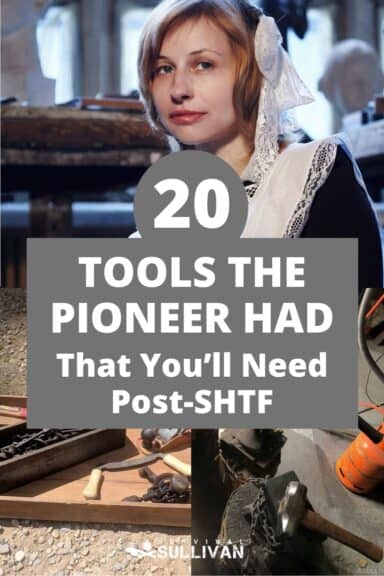
The post 20 Tools the Pioneer Had That You’ll Need Post-SHTF appeared first on Survival Sullivan.
By: Tom Marlowe
Title: 20 Tools the Pioneer Had That You’ll Need Post-SHTF
Sourced From: www.survivalsullivan.com/pioneer-tools/
Published Date: Sat, 28 Sep 2024 12:03:26 +0000
------------------------
Did you miss our previous article...
https://bushcrafttips.com/bushcraft-news/top-20-prepper-items-to-hunt-for-at-flea-markets
 What is BushcraftSurvival SkillsToolsVideosBushcraft CampsBushcraft KitsBushcraft ProjectsPrivacy PolicyTerms And Conditions
What is BushcraftSurvival SkillsToolsVideosBushcraft CampsBushcraft KitsBushcraft ProjectsPrivacy PolicyTerms And Conditions
